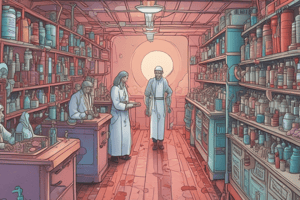Podcast
Questions and Answers
What is the primary function of chemotherapeutic agents?
What is the primary function of chemotherapeutic agents?
- To enhance bacterial cell wall formation
- To selectively act against microbes or malignant cells (correct)
- To affect body cells
- To promote microbial growth
What is true about all antibiotics?
What is true about all antibiotics?
- They can target body cells
- They are not always antimicrobials
- They are produced from microbes (correct)
- They are always bactericidal
What is the term for the destruction or dissolution of bacterial cells?
What is the term for the destruction or dissolution of bacterial cells?
- Bacteriostatic
- Bactericidal
- Antibiotic
- Bacteriolytic (correct)
What is characteristic of Gram positive bacterial cell walls?
What is characteristic of Gram positive bacterial cell walls?
Who is considered the 'Father of Chemotherapy'?
Who is considered the 'Father of Chemotherapy'?
What was discovered by Fleming, Chain, and Florey?
What was discovered by Fleming, Chain, and Florey?
In what year were sulphonamides discovered?
In what year were sulphonamides discovered?
What is true about the outer membrane of Gram negative bacteria?
What is true about the outer membrane of Gram negative bacteria?
What is the mechanism of action of β-lactams?
What is the mechanism of action of β-lactams?
Which of the following antibiotics is an inhibitor of cell membrane leakage?
Which of the following antibiotics is an inhibitor of cell membrane leakage?
What is the mechanism of action of sulfonamides?
What is the mechanism of action of sulfonamides?
What is the classification of Ampicillin based on its spectrum of activity?
What is the classification of Ampicillin based on its spectrum of activity?
Why are human cells not affected by β-lactams?
Why are human cells not affected by β-lactams?
What is the characteristics of penicillins that make them ideal antibiotics?
What is the characteristics of penicillins that make them ideal antibiotics?
Which of the following antibiotics is an inhibitor of DNA-dependent RNA polymerase?
Which of the following antibiotics is an inhibitor of DNA-dependent RNA polymerase?
What is the difference between human and bacterial cells that makes antibacterial therapy possible?
What is the difference between human and bacterial cells that makes antibacterial therapy possible?
What is the name of the first penicillin available?
What is the name of the first penicillin available?
Which type of bacteria is Penicillin G active against?
Which type of bacteria is Penicillin G active against?
What is the preferred drug for pharyngitis caused by Streptococcus pyogenes?
What is the preferred drug for pharyngitis caused by Streptococcus pyogenes?
What is the preferred drug for infections caused by Bacillus anthracis?
What is the preferred drug for infections caused by Bacillus anthracis?
What is the primary treatment for meningitis caused by Neisseria meningitidis?
What is the primary treatment for meningitis caused by Neisseria meningitidis?
What is the drug of choice for syphilis?
What is the drug of choice for syphilis?
What is the name of the spirochete that causes syphilis?
What is the name of the spirochete that causes syphilis?
What is the characteristic of Penicillin G?
What is the characteristic of Penicillin G?
What is the main difference between penicillin V and penicillin G?
What is the main difference between penicillin V and penicillin G?
What is a common side effect of penicillins?
What is a common side effect of penicillins?
What is the purpose of β-lactamase resistant penicillins?
What is the purpose of β-lactamase resistant penicillins?
What is the term used to describe staphylococcal strains that are resistant to methicillin and other penicillinase-resistant penicillins?
What is the term used to describe staphylococcal strains that are resistant to methicillin and other penicillinase-resistant penicillins?
What is the treatment of choice for methicillin-resistant Staphylococcus aureus?
What is the treatment of choice for methicillin-resistant Staphylococcus aureus?
How is nafcillin usually administered?
How is nafcillin usually administered?
Which of the following is not a broad-spectrum penicillin?
Which of the following is not a broad-spectrum penicillin?
Which of the following is formulated for oral dosing?
Which of the following is formulated for oral dosing?
Why is an antipseudomonal aminoglycoside added to the regimen?
Why is an antipseudomonal aminoglycoside added to the regimen?
What is a side effect of piperacillin?
What is a side effect of piperacillin?
Why is piperacillin administered parenterally?
Why is piperacillin administered parenterally?
What is the purpose of beta-lactamase inhibitors?
What is the purpose of beta-lactamase inhibitors?
Which of the following is a beta-lactamase inhibitor?
Which of the following is a beta-lactamase inhibitor?
What is the characteristic of cephalosporins?
What is the characteristic of cephalosporins?
What is the structure of cephalosporins?
What is the structure of cephalosporins?
Who discovered the 1st cephalosporin?
Who discovered the 1st cephalosporin?
Study Notes
Antimicrobials and Antineoplastic Agents
- Chemotherapeutic agents selectively act against microbes or malignant cells, without affecting body cells.
- Antimicrobials are used to treat infectious diseases caused by microbes, and antibiotics are a type of antimicrobial produced by microbes to inhibit or kill other microbes.
Terminologies
- Bacteriostatic: stops the growth of bacteria
- Bactericidal: kills bacteria
- Bacteriolytic: destruction or dissolution of bacterial cells
Gram Positive and Gram Negative Bacteria
- Gram positive bacteria have a thick cell wall and peptidoglycan directly accessible from the environment.
- Gram negative bacteria have a thin cell wall, surrounded by an inner and outer membrane, with lipopolysaccharides, phospholipids, and proteins, making it a barrier to antibiotic diffusion.
Historical Perspectives
- 1877: Louis Pasteur discovered the phenomenon of antibiosis.
- 1906: Paul Ehrlich coined the term "chemotherapy" and is considered the father of chemotherapy.
- 1935: Domagk discovered sulfonamides (Prontosil to sulphanilamide).
- 1929, 1939, 1941: Fleming, Chain, and Florey discovered penicillin from penicillium.
- Waksman discovered streptomycin from actinomycetes and coined the term "antibiotic".
Antimicrobial Classification
- Classification by chemical structure (e.g., β-lactams, aminoglycosides)
- Classification by mechanism of action (e.g., inhibitors of cell wall synthesis)
- Classification by activity against organisms (e.g., anti-bacterial, anti-fungal)
- Classification by spectrum of activity (e.g., narrow, broad, extended)
- Classification by origin/source of antimicrobials
Classification by Organism Affected
- Anti-viral
- Anti-bacterial
- Anti-fungal
- Anti-protozoal
- Anthelmintic
Classification by Spectrum
- Narrow spectrum: e.g., penicillin G, streptomycin, erythromycin
- Broad spectrum: e.g., tetracycline, chloramphenicol
- Extended spectrum: e.g., ampicillin, amoxicillin
Classification by Mechanism of Action
- Cell wall synthesis inhibition: e.g., β-lactams, vancomycin, cycloserines
- Cell membrane leakage: e.g., polypeptides, polyenes
- Folate synthesis inhibition: e.g., sulfonamides, pyrimethamine, cotrimaxazole
- DNA gyrase and topoisomerase inhibition: e.g., fluoroquinolones
- RNA polymerase inhibition: e.g., rifampicin
- Protein synthesis inhibition: e.g., aminoglycosides, tetracyclines, chloramphenicol, macrolides
Differences in Human and Bacterial Cell Components
- Human cells lack a cell wall (peptidoglycans = peptides + sugar)
- Human cell membrane is different (bacteria contain hypanoids in place of sterol)
- Human cells take preformed dihydrofolic acid (no need for PABA in humans)
- Dihydrofolic acid reductase enzyme is different (thousand-time affinity)
- Topoisomerase II are different (in bacteria, DNA gyrase)
- DNA-dependent RNA polymerase is different
- Ribosome 60S subunit for human (in bacteria, 50S)
- Ribosome 40S subunit for human (in bacteria, 30S)
Penicillins
- Penicillins are bactericidal and active against a variety of bacteria, with low direct toxicity.
- Examples: ampicillin, amoxicillin, carbenicillin, ticarcillin
- Spectrum: narrow spectrum to broad spectrum
- Pharmacokinetics: vary depending on the specific penicillin
β-Lactamase Resistant Penicillins
- Examples: flucloxacillin, methicillin, nafcillin, oxacillin, dicloxacillin
- Spectrum: very narrow, active against penicillinase-producing staphylococci
- Pharmacokinetics: vary depending on the specific penicillin
Broad-Spectrum Penicillins
- Examples: ampicillin, amoxicillin
- Spectrum: broad spectrum, active against a variety of bacteria
- Pharmacokinetics: vary depending on the specific penicillin
Cephalosporins
- Cephalosporins are beta-lactam antibiotics, similar in structure and actions to penicillins.
- They are bactericidal, often resistant to beta-lactamases, and active against a broad spectrum of pathogens.
- Classification: 1st generation, 2nd generation, 3rd generation
- Examples: cephalexin, cefuroxime, cefamandole
Studying That Suits You
Use AI to generate personalized quizzes and flashcards to suit your learning preferences.
Description
This quiz covers the basics of antimicrobials and chemotherapeutic agents, including their selective action against microbes or malignant cells.




